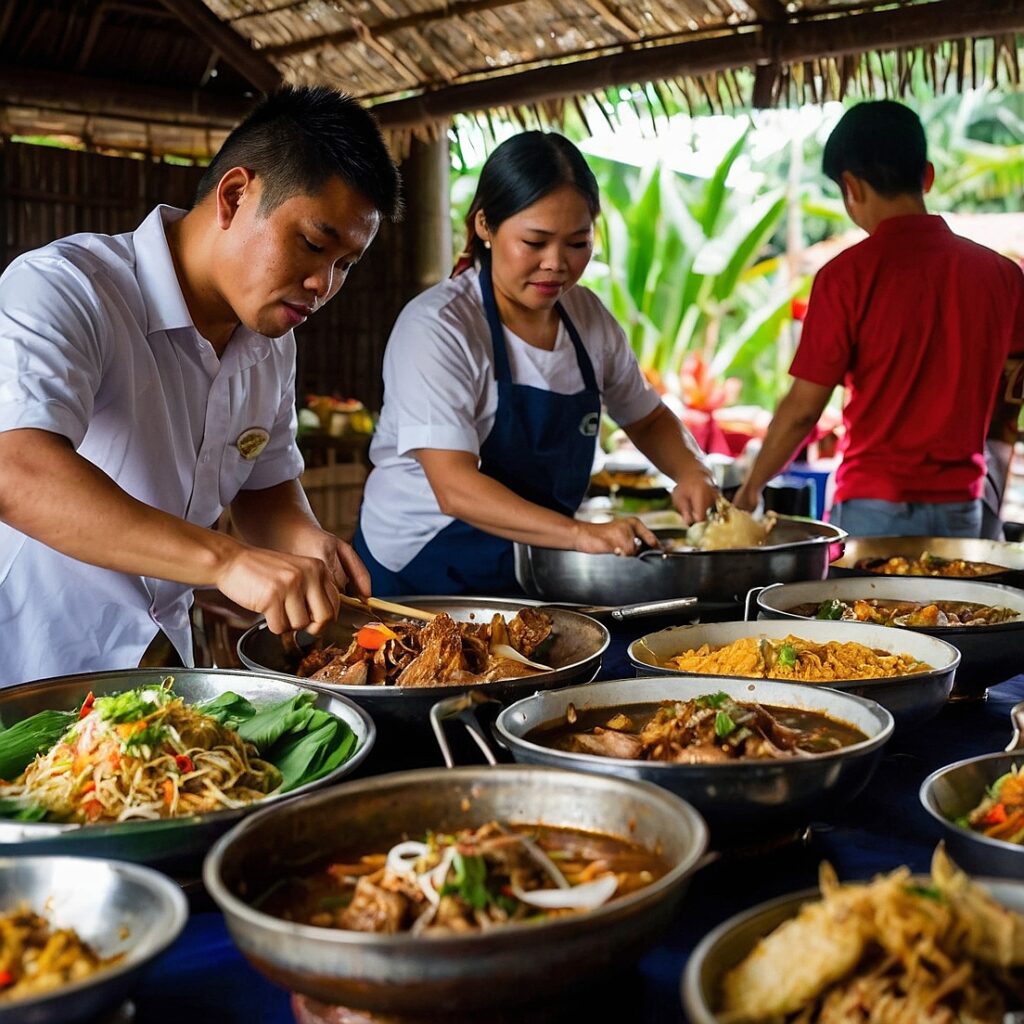Picture this: vibrant streets pulsating with energy, the rhythmic beat of drums filling the air, and a kaleidoscope of colors as far as the eye can see. Welcome to the Ati-Atihan Festival, one of the Philippines’ most exhilarating cultural celebrations! But amidst the dazzling parades and lively performances, there’s another star of the show that’s sure to captivate your senses – the mouthwatering array of street food. As you navigate the bustling streets of Kalibo, Aklan, during this festive extravaganza, you’ll find yourself surrounded by tantalizing aromas and flavors that are as much a part of the Ati-Atihan experience as the music and dancing. In this blog post, we’ll take you on a culinary journey through the must-try treats that make the Ati-Atihan Festival a food lover’s paradise. So, grab a napkin and prepare your taste buds for an unforgettable gastronomic adventure!
The Heart of Ati-Atihan: A Brief History
Before we dive into the delectable world of Ati-Atihan street food, let’s take a moment to appreciate the rich history behind this incredible festival. The Ati-Atihan Festival, which means “to be like Atis” or “to make oneself like Atis,” is a centuries-old celebration that honors the Santo Niño (Child Jesus) and commemorates the legendary exchange of land between the Ati people and Malay settlers. This vibrant festival, held annually in January, has evolved into a grand spectacle that attracts thousands of visitors from all over the Philippines and beyond.
The festival’s roots can be traced back to the 13th century, and over the years, it has grown to encompass not just religious observances but also a wide array of cultural performances, parades, and, of course, an abundance of delicious food. As you wander through the streets during Ati-Atihan, you’ll find yourself immersed in a sensory overload of sights, sounds, and tastes that truly capture the essence of Filipino culture and hospitality.
The Street Food Scene: A Gastronomic Paradise
A Melting Pot of Flavors
One of the most exciting aspects of the Ati-Atihan Festival is the incredible variety of street food on offer. As you explore the festival grounds, you’ll encounter an eclectic mix of traditional Filipino dishes, regional specialties, and innovative culinary creations that reflect the diverse influences on Aklan’s cuisine. From savory snacks to sweet treats, there’s something to satisfy every craving and tantalize every palate. The street food scene at Ati-Atihan is a testament to the Filipino love for good food and the joy of sharing meals with friends and strangers alike.
A Feast on Every Corner
During the festival, the streets of Kalibo transform into a sprawling open-air food market, with vendors setting up makeshift stalls and food carts on nearly every corner. The air is filled with the sizzle of grilling meats, the aroma of freshly cooked rice, and the sweet scent of various desserts. As you navigate through the crowd, you’ll find yourself constantly tempted by the colorful displays of food and the enthusiastic calls of vendors inviting you to try their specialties. It’s a food lover’s paradise where you can sample a wide range of dishes without breaking the bank.
Must-Try Savory Treats
Inasal: The King of Grilled Chicken
No visit to the Ati-Atihan Festival would be complete without indulging in the iconic Inasal. This mouthwatering grilled chicken dish is a staple of Western Visayan cuisine and a true crowd-pleaser at the festival. What sets Inasal apart is its unique marinade, typically consisting of vinegar, calamansi juice, lemongrass, garlic, and annatto oil, which gives the chicken its distinctive reddish-orange hue. As you bite into a juicy piece of Inasal, you’ll be treated to a perfect balance of tangy, savory, and slightly sweet flavors that will leave you craving more.
Lechon: The Crown Jewel of Filipino Feasts
While not exclusively a street food, you’ll find plenty of vendors selling portions of the beloved Lechon during Ati-Atihan. This whole roasted pig is a centerpiece of Filipino celebrations, and the festival is no exception. The crispy, golden-brown skin and tender, flavorful meat make Lechon an irresistible treat for many festival-goers. Don’t be surprised if you find yourself joining the queue for a taste of this succulent delicacy – it’s well worth the wait!
Batchoy: A Bowl of Comfort
As you explore the festival, keep an eye out for vendors selling steaming bowls of Batchoy. This hearty noodle soup, which originated in nearby Iloilo City, is the perfect comfort food to warm you up and refuel your energy. A typical bowl of Batchoy contains egg noodles, pork organs, crushed pork cracklings, chicken stock, beef loin, and garlic. The rich, savory broth and tender meat make it a satisfying meal that’s especially popular during the cooler evening hours of the festival.
Seafood Sensations
Grilled Seafood Galore
Given Aklan’s coastal location, it’s no surprise that seafood plays a starring role in the Ati-Atihan street food scene. As you wander through the festival, you’ll encounter numerous vendors offering an array of freshly grilled seafood. From succulent shrimp and squid to whole fish and shellfish, there’s no shortage of options for seafood lovers. The smell of grilling fish and the sight of perfectly charred seafood skewers are sure to make your mouth water.
Kinilaw: The Filipino Ceviche
For a refreshing break from heavier dishes, try the local version of Kinilaw. This dish, similar to Latin American ceviche, features fresh raw fish or seafood marinated in vinegar, calamansi juice, and spices. The tangy, zesty flavors of Kinilaw make it a perfect palate cleanser between other street food indulgences. Look for vendors selling small portions of Kinilaw served in cups or on skewers – it’s a delightful way to cool down and enjoy the fresh flavors of the sea.
Sweet Treats and Desserts
Halo-Halo: A Rainbow in a Glass
No Filipino food adventure would be complete without trying the iconic Halo-Halo. This beloved dessert, whose name literally means “mix-mix,” is a colorful concoction of shaved ice, sweetened beans, fruits, jellies, and other toppings, all crowned with a scoop of ube (purple yam) ice cream and a drizzle of evaporated milk. During Ati-Atihan, you’ll find numerous vendors selling their own unique versions of Halo-Halo. It’s the perfect treat to cool down and satisfy your sweet tooth amidst the festival’s excitement.
Bibingka and Puto Bumbong: Christmas Favorites Year-Round
Although traditionally associated with the Christmas season, you’ll often find vendors selling Bibingka and Puto Bumbong during Ati-Atihan. Bibingka is a warm, slightly sweet rice cake cooked in banana leaves, often topped with salted egg, cheese, and grated coconut. Puto Bumbong, on the other hand, is a purple rice cake steamed in bamboo tubes and served with butter, sugar, and grated coconut. These festive treats offer a taste of Filipino holiday traditions any time of the year.
Unique Ati-Atihan Specialties
Inubarang Manok: A Local Delicacy
One dish you absolutely must try during Ati-Atihan is Inubarang Manok, a specialty of Kalibo. This unique chicken dish is cooked with ubad (banana pith), giving it a distinctive texture and flavor. The chicken is simmered in a flavorful broth along with vegetables and spices, resulting in a comforting and satisfying meal. It’s a true taste of local Aklanon cuisine that you won’t find in many other places.
Binakol: Coconut Water Chicken Soup
Another local favorite you might encounter during the festival is Binakol. This comforting chicken soup is cooked with young coconut water and meat, giving it a subtle sweetness and unique flavor profile. Often seasoned with lemongrass, ginger, and other aromatic herbs, Binakol is both nourishing and refreshing – perfect for revitalizing your energy during the festival.
Navigating the Street Food Scene
Tips for a Safe and Enjoyable Experience
While indulging in street food is an essential part of the Ati-Atihan experience, it’s important to keep a few tips in mind to ensure a safe and enjoyable culinary adventure:
- Look for popular stalls with high turnover: Busy vendors are more likely to have fresh ingredients and maintain good hygiene practices.
- Observe the cooking process: When possible, watch how your food is prepared to ensure it’s cooked thoroughly.
- Bring your own utensils and hand sanitizer: While many vendors provide disposable utensils, having your own set can be more hygienic and environmentally friendly.
- Stay hydrated: With all the walking and eating, it’s crucial to drink plenty of water. Look for vendors selling fresh coconut water or other sealed beverages.
- Pace yourself: With so many delicious options available, it’s tempting to try everything at once. Take your time and spread your culinary exploration over the course of the festival.
Budget-Friendly Feasting
One of the great things about street food at Ati-Atihan is its affordability. You can sample a wide variety of dishes without breaking the bank. Here’s a rough guide to help you budget for your street food adventure:
| Item | Price Range (PHP) |
|---|---|
| Inasal (per serving) | 50-100 |
| Lechon (per 100g) | 80-150 |
| Batchoy (per bowl) | 60-120 |
| Grilled Seafood Skewer | 30-80 |
| Halo-Halo | 40-100 |
| Bibingka | 30-70 |
| Inubarang Manok (per serving) | 70-130 |
Please note that prices may vary depending on the vendor and the specific festival year.
The Cultural Significance of Food at Ati-Atihan
Culinary Traditions and Community
Food plays a central role in Filipino culture, and this is especially evident during festivals like Ati-Atihan. The act of sharing meals and trying new dishes together creates a sense of community and camaraderie among festival-goers. As you sample the various street foods, you’ll notice locals and visitors alike engaging in lively conversations, exchanging recommendations, and bonding over their culinary discoveries. This shared experience of food is an integral part of the festival’s spirit of unity and celebration.
Preserving Heritage Through Flavor
Many of the dishes you’ll encounter at Ati-Atihan have been passed down through generations, preserving the culinary heritage of Aklan and the wider Visayas region. By supporting local vendors and trying traditional dishes, you’re not just satisfying your hunger – you’re also participating in the continuation of these important cultural traditions. Each bite of Inasal, spoonful of Batchoy, or taste of Inubarang Manok connects you to the rich history and vibrant culture of the Philippines.
A Feast to Remember
As the drums beat and the streets come alive with the spirit of Ati-Atihan, allow yourself to be swept up in the culinary adventure that awaits. From the savory delights of Inasal and Lechon to the sweet indulgence of Halo-Halo and Bibingka, the street food scene at this vibrant festival offers a true feast for the senses. Each dish tells a story, carrying with it the flavors of tradition and the warmth of Filipino hospitality.
So, as you plan your visit to the Ati-Atihan Festival, come with an empty stomach and an open mind. Be prepared to join the throngs of food lovers exploring the bustling streets, following your nose from one tempting aroma to the next. Engage with the friendly vendors, chat with fellow festival-goers about their favorite finds, and don’t be afraid to try something new. The street food of Ati-Atihan is more than just sustenance – it’s an integral part of the festival experience, a delicious way to connect with the local culture, and a memory you’ll cherish long after the last drumbeat fades away.
Whether you’re a seasoned foodie or a curious first-time visitor, the street food at Ati-Atihan promises an unforgettable gastronomic journey. So, grab a plate, join the festive crowd, and get ready to eat your way through one of the Philippines’ most exciting cultural celebrations. Viva Señor Santo Niño, and bon appétit!
Disclaimer: The information in this blog post is based on research and personal experiences up to 2021. Prices, availability, and specific dishes may vary in subsequent years. We encourage readers to verify current information when planning their visit to the Ati-Atihan Festival. If you notice any inaccuracies, please report them so we can correct them promptly.




